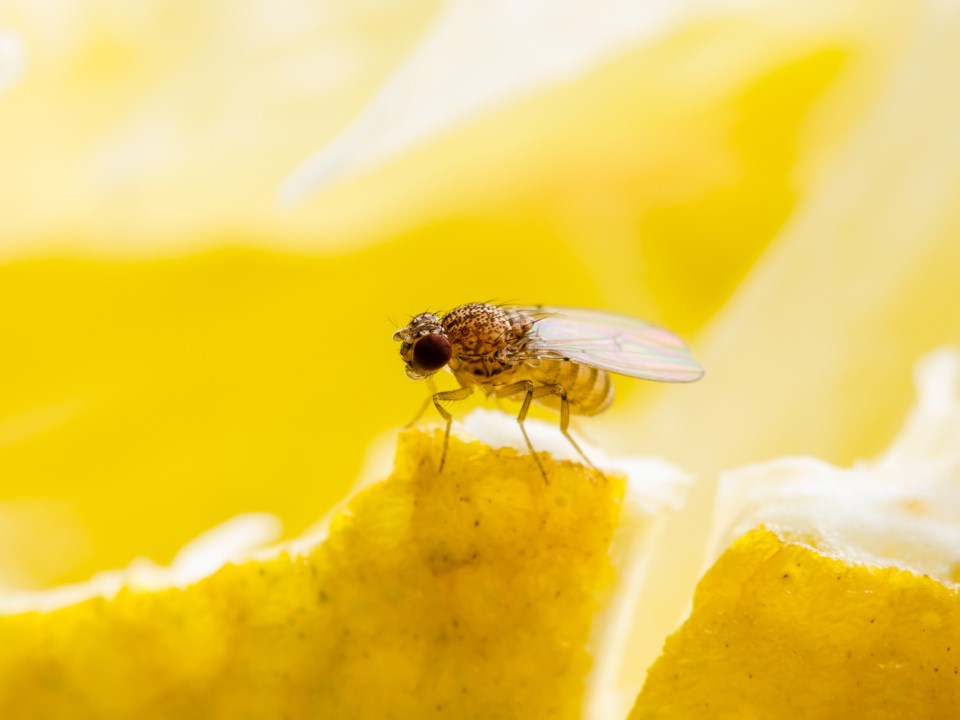Never mind those ants in our pants. (Take a boo at my last Pique instalment for more on that topic.) Now we’ve got millions of fruit flies in our eyes!
I’ve seen it all—friends and neighbours, co-workers in pubs and restaurants, jumping and hopping around kitchens at home and at work like madmen possessed, whacking and smacking dish cloths, bar towels, anything they can get their hands on, including their hands. Slapping, clapping, flapping—trying whatever it takes to get one more annoying fruit fly into its grave.
Then there’re the diligent ones, scrubbing every shelf in sight in case some sticky residue is attracting their nemesis. Plus we have the “cover-up” solutions: Like putting all those gorgeous fresh peaches, nectarines, berries—whatever super seasonal fruit people have picked up at their favourite farmers’ market in Whistler, Squamish, Pemberton, and beyond that they don’t want to nosh down cold, straight from the fridge—under upside-down bowls on the counter. There’s even the old tea-towel-covering trick.
But all is for naught. For here they come again and again, those dang intrepid fruit flies, barely disturbed by our frustrated human flailings.
’TIS THE SEASON
In Latin, Drosophila melanogaster is the type of fruit fly we get here. According to the University of Washington, it’s also the type that’s been used in research for more than a century, to study genetics, behaviour and immunology for many reasons, which also make them great for study in high school labs. To start, they’re small and easy to handle. They can be manipulated easily with unsophisticated equipment. Plus males and females are easy to distinguish so it’s equally easy to determine genetic differences and how traits are inherited—a critical point for medical research.
Drosophila means “dew-loving” and melanogaster means “black belly.” But there are several varieties of fruit flies, including one found in places like Australia and the Mediterranean, which aren’t just a nuisance. These can cause devastating losses to local fruit industries, which are already coping with the climate crisis delivering all sorts of freakish challenges, from droughts to flooding and wild temperature fluctuations.
Depending on the climate and location, fruit flies can plague us year-round especially in “banana belt” regions. But in this neck of the woods, they don’t usually come out in droves until, you guessed it—temperatures climb and ripened fruit is yours for the taking, often for free.
Check out your favourite neighbourhood Facebook page this time of year. Bet you’ll find offers from people with apple trees or berry bushes begging you to come pick what you want for free so the fruit doesn’t go to waste—or to hungry fruit flies. Plus you’ve got lots of choices for delicious, reasonably priced u-picks, like up at North Arm Farm in Pemberton.
Heat? Fruit flies love it, and surely it’s been h-o-t right across Canada lately, and getting hotter and hotter more often. In fact, 60—count ’em—heat records were broken across our fair nation on a single day, this past Monday, Aug. 11. Never mind the record-breaking heat waves in Europe this summer. As Environment Canada’s meteorologist extraordinaire, David Phillips, says, get used to it. This is “a dress rehearsal, a dry run,” he says, the start of things to come with searing temperatures like these expected to be the norm in 25 years.
Add that to some of the juiciest, tastiest, most luscious tree fruits and berries ever coming out of the Okanagan and Fraser and Pemberton valleys, and you’ve got yourself fruit fly heaven.
KEEPING POPULATIONS UNDER CONTROL
We could talk about a few populations here that need controlling (ahem). But in this case, I only mean those pesky kitchen fruit flies.
However, before we get into that, to be fair, there are some pretty fascinating things about these little guys despite everything. Wiki has a great entry on Drosophila, including a recording of their heartbeat (sounds amazingly human!), and other cool tidbits, like about 75 per cent of disease-causing genes in humans have a functional equivalent in the fruit fly genome, ergo their use as one of the first organisms in genetic research.
Now don’t get me wrong. I’m not saying simply leave the little guys alone. But if you decide to do so, you might find they’re not as annoying as they seem, plus you’ll save all kinds of effort. I think that’s called an attitude shift.
First of all, the kind of fruit flies we get here in B.C. are not the type that cause fruit to rot. They’re attracted to fruit that’s already ripe or beyond. Yes, they can carry bacteria like salmonella from unsanitary things like garbage or your pet’s food and water bowls, if you don’t wash them regularly. But our fruit flies don’t cause serious diseases.
HOT TIPS
After years of living in warm climates like Hawaii and southern California, I’ve learned a couple of tricks that work. One, if you keep a small compost container indoors, during fruit fly season dump your apple cores etc. into a small container in your freezer. Then plunk it all into your bigger compost bin when you dump it at Nesters or Function Junction.
You’ll find tons of suggestions online for fruit fly traps. Some work, some don’t. But a pretty reliable one we’ve used is also super easy. Simply dribble a bit of attractant into a tiny dish. Try watery orange or mango juice. Add small dabs of honey or Nonna Pia’s Balsamic Glaze. Even fruit flies can’t resist that. Tightly wrap a small piece of plastic wrap over top of the dish and punch maybe three holes in it with a toothpick. The trick is to make the holes big enough to attract the flies inside, and small enough they can’t get out—just like any good animal trap.
After that, sit back and watch. Maybe you or your kids will become entomologists after all.
Glenda Bartosh is an award-winning journalist who has a microscope right in her office.




